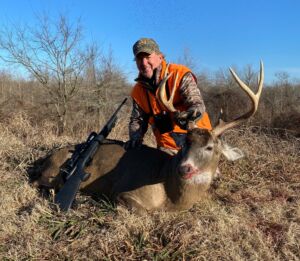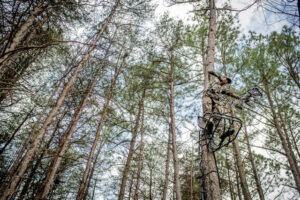 Many Midwestern and Northern states have a loosely defined breeding period of 10 days to 3 weeks in November, but it’s more of a strung-out “trickle rut” in most Southern regions, especially the deeper in Dixie you go. Deer breeding in the South is extended because of the mild winters; does can drop fawns later in summer and the little deer can survive the next winter.
Many Midwestern and Northern states have a loosely defined breeding period of 10 days to 3 weeks in November, but it’s more of a strung-out “trickle rut” in most Southern regions, especially the deeper in Dixie you go. Deer breeding in the South is extended because of the mild winters; does can drop fawns later in summer and the little deer can survive the next winter.
From late October (Georgia, South Carolina) to mid-November (Virginia, Tennessee, Kentucky) into December (Mississippi) and January and even February (Alabama), expect spotty periods of bucks pushing does for 4 to 7 weeks or longer, with many slow days in between.
While there some fine managed properties in the South, most people hunt public land or small private woods where the habitat is raw and pretty rough. On these lands, the buck:doe ratio of the herds is typically out of whack (too many does), and that, too, extends the rut. Warm to hot weather is a factor. It may be 70 to 80 degrees and humid for a week or longer; bucks run does in the cooler nights, though you won’t see the action.
Since the deer movement is so variable and unpredictable, I believe your best strategy is scout well and hang a stand or set a blind in an obvious travel corridor. Hunt that funnel for days and weeks during the extended rut, and sooner or later you’ll see a shooter.
Here are 2 great sets that will work anywhere in the South.
A strip of timber between 2 fields or logging cuts, a long hardwood draw, a twisting, brushy creek bottom… Any long, linear funnel that connects core areas where groups of does bed and feed is a hotspot in the rut. Research of GPS-collared Southern deer shows that throughout the rutting period, bucks make long and linear excursions to maximize their chances of contacting hot does.
Set 2 or 3 tree stands or blinds several hundred yards apart along a funnel, on the downwind side of trails blazed with scrapes and rubs or, better yet, at the junction of several well-used paths. Try to position on a point or ridge side that commands a good view of a funnel below. Hunt there long enough and you’re guaranteed to see deer; there’s a good chance one will be a shooter buck.
Years ago, I hunted with a man named Joe Champion, who told me about his best stand he was fixing to put me in. “I think I hung it back in the 70s,” said Joe, who at the time managed the hunting on a 15,000-acre paper-company lease. “Lost track of all the 240-pound-plus bucks that stand has produced. To this day you can’t sit there 2 days in a row in the rut and not see at least one huge deer.”
It’s one of those unique “pinches” you ought to look for in the South, especially if you hunt water country. The stand was tight to the Alabama River. Beaver ponds wrapped around it to create a big timber peninsula. The stand is positioned to cover the stem of dry ground that connects the peninsula to the main woods. When the water is up, the strip is only 2 to 3 feet wide in places. That hardly bothers the black-legged swamp deer, which trample the strip to mud during the rut. “Man, we’ve shot some great deer in that spot,” said Joe, including the 200-pound 9-pointer I killed one January morning.
3 more quick tips for the Southern rut:
- A Tennessee study found that bucks love to rub trees along fingers of timber that drop off the sides of oak ridges. Scout those fingers, find the rub lines and hang stands.
- University of Georgia research: Multiple bucks hit one set of scrapes while other scrapes 100 yards away go dormant. Scout, move and hunt the hottest sign.
- A can call that produces doe bleats can lure a prowling buck any day in December or January. Keep bleats short and sweet: meaa, meaa. Back up with grunts.
Southern Gun Tactics
Across the Southeast, gun hunters register 75% of the annual deer kill. In many states rifle season is a month or longer. Hunters bust deer and shoot some, miss some. Old bucks become ultra-spooky and largely nocturnal.
A South Carolina study focused on blinds set in food plots and over corn feeders. Researchers found that if a stand had not been hunted in the previous 5 days, deer were attracted to the site. But when a stand was hunted just one day, most bucks avoided that spot for the next 3 days and often longer. The takeaway: You’d better have a pressure plan for gun season.
If you hunt public land or private club ground with 10 or more rifle hunters, let them have the fields, cutovers, creek funnels and other “best” spots. You check an aerial map on an app and go the thickest, roughest hell-holes a half-mile or more away. That’s where the big bucks will go to flee the pressure. Here a 2 great sets.
Cover ground and look for a spot where 2 or 3 ridges converge and peter out into a secluded creek or river bottom. The nastier the cover the better. Set a stand or blind on a vantage 100 yards or so downwind of a convergence of hills and watch for a day or two. If and when a burly shooter rolls by, take him.
In rifle season I look for the narrowest point between a strip of open ground and 2 blocks of woods or cutovers, and set a stand to cover it. When crossing open ground, bucks will run that choke point between the two timbers or thickets, thereby minimizing their exposure in the open. Stay on your toes and be ready for a quick rifle or muzzleloader shot, because bucks almost always trot from point A to B.
3 more quick tips for Southern gun hunters:
- Kentucky hunter Will Brantley says that when rutting bucks are locked down with does in tiny cover, don’t be afraid to move around. “Three of the biggest deer I’ve ever killed were all on morning hunts in late November, still-hunting with the wind in my face and a rifle or muzzleloader in hand. If you see a mature doe, stop, get set up to shoot and see what happens. A big buck will frequently hold out of sight in cover until she starts to walk away. If he’s there, he’ll follow her, guaranteed.”
- A years-long South Carolina study analyzed 493 deer kills on hunt club land. Hunters used 20 calibers, from .243 to .30-06. As to how quickly deer died or ran after the shot the study found no relationship with increasing or decreasing caliber size. If you want deer to drop on the spot, the study found the shoulder shot is best.
- An Auburn study found that if you hunt food plots, do it on opening day. Researchers found that bucks are 4 times more likely to come to a plot in daylight on the opener than any day later in gun season.







